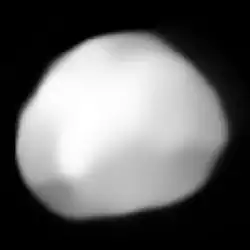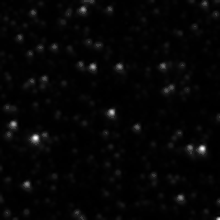704 Interamnia
704 Interamnia is a large F-type asteroid. With an estimated mean diameter of 330 kilometres, it is the fifth-largest asteroid after Ceres, Vesta, Pallas, and Hygiea. Its mean distance from the Sun is 3.067 (AU). It was discovered on 2 October 1910 by Vincenzo Cerulli, and named after the Latin name for Teramo, Italy, where Cerulli worked. It is probably the fifth-to-eighth-most-massive asteroid, with a mass estimated to be 1.2% of the mass of the entire asteroid belt.[5] Observations by the Very Large Telescope's SPHERE imager in 2017–2019, combined with occultation results, indicate that the shape of Interamnia may be consistent with hydrostatic equilibrium for a body of its density with a rotational period of 7.6 hours. (Its current period is 8.7 hours.) This suggests that Interamnia may have formed as an equilibrim body, and that impacts changed its rotational period after it fully solidified.[3]
 VLT-SPHERE image of Interamnia | |
| Discovery | |
|---|---|
| Discovered by | Vincenzo Cerulli |
| Discovery date | 2 October 1910 |
| Designations | |
| (704) Interamnia | |
| Pronunciation | /ɪntərˈæmniə/[1] |
Named after | Teramo |
| 1910 KU; 1952 MW | |
| Main belt | |
| Adjectives | Interamnian /ɪntərˈæmniən/[1] |
| Orbital characteristics[2] | |
| Epoch 31 July 2016 (JD 2457600.5) | |
| Uncertainty parameter 0 | |
| Observation arc | 102.38 yr (37395 d) |
| Aphelion | 3.5293 AU (527.98 Gm) |
| Perihelion | 2.5857 AU (386.82 Gm) |
| 3.0575 AU (457.40 Gm) | |
| Eccentricity | 0.15431 |
| 5.35 yr (1952.8 d) | |
Average orbital speed | 16.92 km/s |
| 276.11° | |
| 0° 11m 3.66s / day | |
| Inclination | 17.309° |
| 280.30° | |
| 95.208° | |
| Physical characteristics | |
| Dimensions | 362 × 348 × 310 ± 8 km[3] |
Mean diameter | 332±6 km (volume equivalent)[3] |
| Mass | (3.79±1.28)×1019 kg[3] |
Mean density | 1.98±0.68 g/cm3[3] |
| 8.712336 h[3] | |
Pole ecliptic latitude | 62±5° |
Pole ecliptic longitude | 87±5° |
| 0.0742±0.002[2] | |
| F/B[2] | |
| 9.9 to 13.0[4] | |
| 5.94[2] | |
Characteristics


Although Interamnia is the largest asteroid after the "big four", it is a very little-studied body. It is easily the largest of the F-type asteroids, but until 2017-2019 there existed very few details of its internal composition or shape, and no light curve analysis has yet been done to determine the ecliptic coordinates of Interamnia's poles (and hence its axial tilt). Studies by the Very Large Telescope give an average diameter of about 332 km and found an ellipsoidal shape for Interamnia, similar to 4 Vesta; the resulting density calculation (1.98 ± 0.68 g · cm^3) is not precise enough to definitely infer Interamnia's composition, but the presence of hydrated materials at the surface and its overall spectral similarities to Ceres suggest that it is likely an icy body. The absence of an affiliated asteroid family implies that Interamnia has not suffered a giant impact within the past 3 billion years,[6] in contrast to 4 Vesta and 10 Hygeia.[7][8]
Its very dark surface and relatively large distance from the Sun means Interamnia can never be seen with 10x50 binoculars. At most oppositions its magnitude is around +11.0, which is less than the minimum brightness of Vesta, Ceres or Pallas. Even at a perihelic opposition its magnitude is only +9.9,[4] which is over four magnitudes lower than Vesta.
Its orbit is slightly more eccentric than that of Hygiea (15% versus 12%) but differs from Hygiea's in its much greater inclination and slightly shorter period. Another difference is that Interamnia's perihelion is located on the opposite side from the perihelia of the "big four", so that Interamnia at perihelion is actually closer to the Sun than Ceres and Pallas are at the same longitude. It is unlikely to collide with Pallas because their nodes are located too far apart, whilst although its nodes are located on the opposite side from those of Ceres, it is generally clear of Ceres when both cross the same orbital plane and a collision is again unlikely.
Surface
There are no deep basins visible in the VLT images. Any large craters must have flat floors, consistent with an icy C/F-type composition.[9]
Mass
In 2001, Michalak estimated Interamnia to have a mass of (7±2)×1019 kg. Michalak's estimate depends on the masses of 19 Fortuna, 29 Amphitrite, and 16 Psyche; thus this mass was obtained assuming an incomplete dynamical model.[10]
In 2011, Baer calculated Interamnia had a mass of (3.9±0.2)×1019 kg.[11]
Goffin's 2014 astrometric reanalysis gives an even lower mass of (2.7±0.1)×1019 kg.[12]
In 2019, Hanuš et al. consolidated 21 selected prior mass estimates, dating from 1992 to 2017, with a metastatistical result of (3.8±1.3)×1019 kg (that is, (2.5 to 5.1)×1019 kg to within 1 sigma uncertainty.[3]

Sun Earth · Mars · Jupiter · 704 Interamnia

See also
References
- "interamnian". Oxford English Dictionary (Online ed.). Oxford University Press. (Subscription or participating institution membership required.)
- "JPL Small-Body Database Browser: 704 Interamnia (1910 KU)" (2008-04-14 last obs). Retrieved 7 May 2016.
- Hanuš, J.; Vernazza, P.; Viikinkoski, M.; Ferrais, M.; Rambaux, N.; Podlewska-Gaca, E.; et al. (2020). "(704) Interamnia: A transitional object between a dwarf planet and a typical irregular-shaped minor body". Astronomy & Astrophysics. 633: A65. arXiv:1911.13049. Bibcode:2020A&A...633A..65H. doi:10.1051/0004-6361/201936639. S2CID 208512707.
- "Bright Minor Planets 2007". Minor Planet Center. Retrieved 21 May 2008.
- Pitjeva, E. V. (2005). "High-Precision Ephemerides of Planets—EPM and Determination of Some Astronomical Constants" (PDF). Solar System Research. 39 (3): 176–186. Bibcode:2005SoSyR..39..176P. doi:10.1007/s11208-005-0033-2. S2CID 120467483. Archived from the original (PDF) on 31 October 2008. 15 = 0.0124
- Hanuš, J.; Vernazza, P.; Viikinkoski, M.; Ferrais, M.; Rambaux, N.; Podlewska-Gaca, E.; Drouard, A.; Jorda, L.; Jehin, E.; Carry, B.; Marsset, M.; Marchis, F.; Warner, B.; Behrend, R.; Asenjo, V.; Berger, N.; Bronikowska, M.; Brothers, T.; Charbonnel, S.; Colazo, C.; Coliac, J.-F.; Duffard, R.; Jones, A.; Leroy, A.; Marciniak, A.; Melia, R.; Molina, D.; Nadolny, J.; Person, M.; et al. (2020). "(704) Interamnia: A transitional object between a dwarf planet and a typical irregular-shaped minor body". Astronomy & Astrophysics. 633: A65. arXiv:1911.13049. Bibcode:2020A&A...633A..65H. doi:10.1051/0004-6361/201936639. S2CID 208512707.
- Schenk, P.; O'Brien, D. P.; Marchi, S.; Gaskell, R.; Preusker, F.; Roatsch, T.; Jaumann, R.; Buczkowski, D.; McCord, T.; McSween, H. Y.; Williams, D.; Yingst, A.; Raymond, C.; Russell, C. (2012). "The Geologically Recent Giant Impact Basins at Vesta's South Pole". Science. 336 (6082): 694–697. Bibcode:2012Sci...336..694S. doi:10.1126/science.1223272. PMID 22582256. S2CID 206541950.
- https://www.eso.org/public/archives/releases/sciencepapers/eso1918/eso1918a.pdf
- Hanuš et al. 2020
- Michalak, G. (2001). "Determination of asteroid masses". Astronomy & Astrophysics. 374 (2): 703–711. Bibcode:2001A&A...374..703M. doi:10.1051/0004-6361:20010731.
- Baer, James (2010). "Recent Asteroid Mass Determinations". Personal Website. Archived from the original on 2 July 2013. Retrieved 13 February 2011.
- Goffin, Edwin (2014). "Astrometric asteroid masses: A simultaneous determination". Astronomy & Astrophysics. 565: A56. arXiv:1402.4241. Bibcode:2014A&A...565A..56G. doi:10.1051/0004-6361/201322766. S2CID 118444915.
External links
- Animation of Asteroid Interamnia taken on 1 & 2 April 2003
- Interamnia Occultations Observed before 2003
- Occultation of GSC 23450183 by 704 Interamnia on 17 December 1996
- Occultation of HIP36189 by 704 Interamnia on 23 March 2003
- (704) Interamnia: A transition object between a dwarf planet and a typical irregular-shaped minor body
- 704 Interamnia at AstDyS-2, Asteroids—Dynamic Site
- 704 Interamnia at the JPL Small-Body Database
